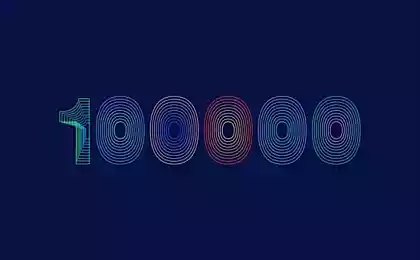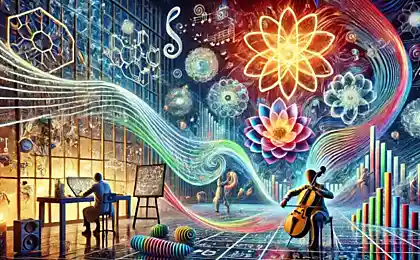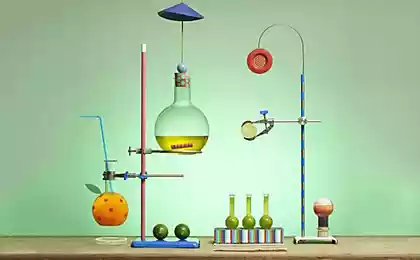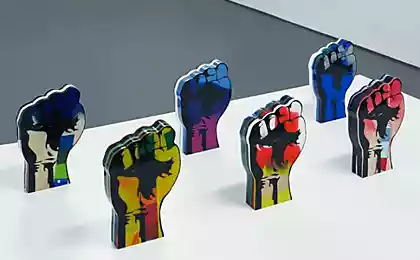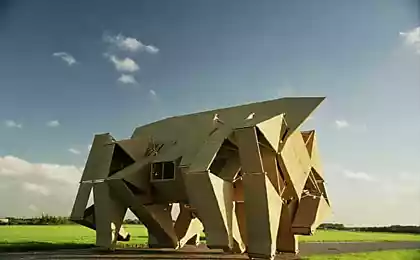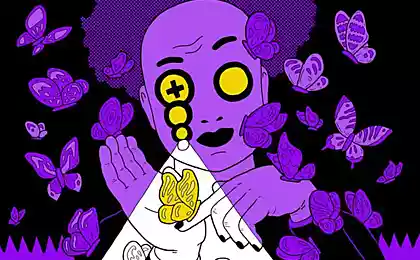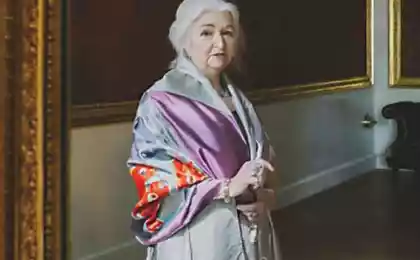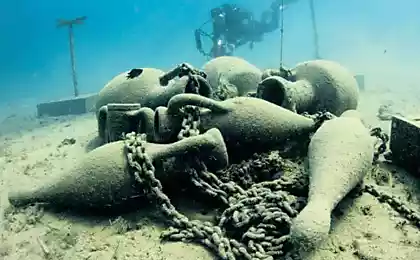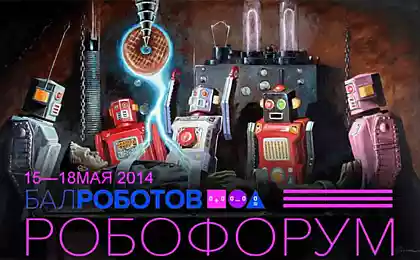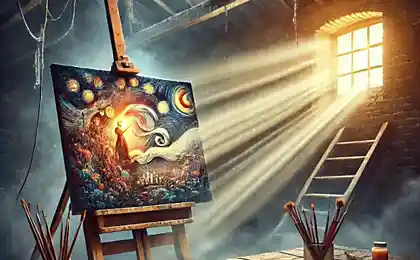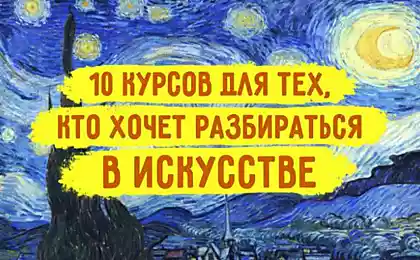901
10 projects at the intersection of art and science
When science and art go hand in ruku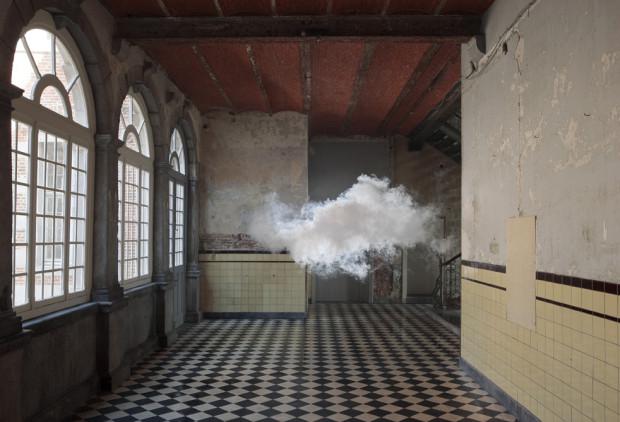
Typically, we divide people into two categories: the analytical, scientific mind and creative. But in real life it's not so simple. There are a lot of artists from the sciences - people who converted to the work of the biology or meteorology. Sometimes very strange way.
1. The meteorite, which will fly back to space
About 5,000 years ago, the Earth fell iron meteorite. It happened near the modern Buenos Aires, Argentina. The meteorite, now known as Campo del Cielo, remained on Earth for thousands of years. Sometimes the natives otkovyrivali away pieces of metal to forge weapons, and some time later the Spaniards dug up the entire area in hopes of finding deposits of iron. And in the end it turned out to be a fragment of a meteorite in a Scottish artist Katie Paterson.
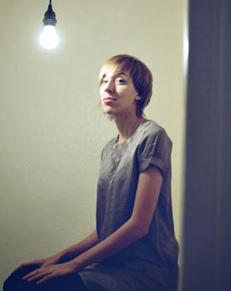
Paterson project called "Campo del Cielo: Golf heaven" sent to be melted meteorite - a piece of iron was melted, poured into a mold and gave the metal to solidify. Iron stone weighing 110 kg then exhibited at Selfridges, London.
But Paterson meteorite is not yet finished. The second phase of the project involves the launch of it back into space.
Paterson, enlist the help of the European Space Agency plans to send the meteorite back to the stars aboard a cargo carrier spacecraft. This is largely a symbolic gesture - Paterson hopes to inspire the next generation so that astronomers and make people think about the origin of life and the universe. That's how a lot of hopes are pinned on a small rock.
2. Clouds in the rooms
Clouds always fascinated people. Who once in my life did not look at the sky castles and furry elephants? Yes, and artists often depict clouds on his canvases - example is the "Scream" Munch or "eight bells" of Homer. A Dutch artist Berndnaut Smild became the first in the world of the creator's own clouds. He threw the brush and paints and rely on science to build real clouds.
Since 2012, the Smild traveled the globe in search of churches and galleries, suited to its meteorological magic. In the end, he finally found the perfect place, brought to the car and began to work. The room should be appropriate "climate" and Smild spends several days to adjust the temperature and humidity, water pouring floors. When the time came, he releases from his fog machine - and there is a cloud.
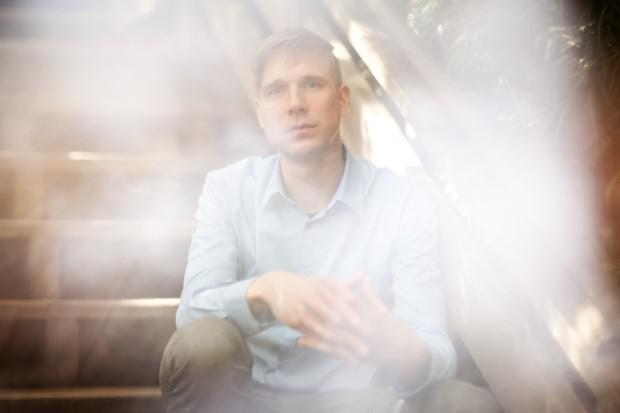
Sometimes Smild makes cumulus, sometimes rain, sometimes cirrus clouds. Unfortunately, there are only a few seconds - during this time, the artist manages to photograph their work. And, despite the scientific approach, Smilda interested in the ephemeral aspect of his work - the cloud lives just a moment, and then disappears.
3. Violet smeschenie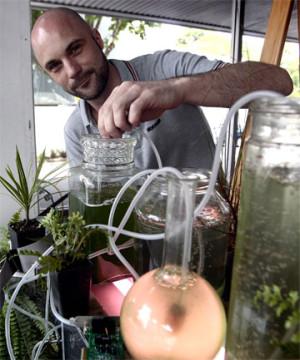
Art lovers, visit the "blue shift" Angelo Vermeulen in 2005, the year got a chance to demonstrate their divine powers. Moreover, an interactive installation that gave the visitors control over life and death, it also gave them the power of the creator.
Teaming up with an evolutionary biologist Luc De Meester, Vermeulen has built a number of aquariums in which swim hungry fish and water fleas. Aquariums have been divided horizontal leaky planks. Holes were small enough to hold the fish at the bottom, but large enough to crustaceans flea can swim freely back and forth. Of course, any water flea knows what is best to stay away from schools of fish, right? Well, it all depends on the lighting.

Located above the aquarium spotlights connected to motion sensors. Most of the time the lights were bright yellow, that fleas was very good - bright yellow light attracted fleas floating in the top of the aquarium. But blue water fleas do not like. Blue means for their open water and, accordingly, predators. Therefore, when a visitor came to the aquarium, yellow was replaced by blue and flea fled in panic to the bottom of the aquarium, to fish. In other words, every man approached the aquarium fleas doomed to destruction.
But some water fleas finally realized what was happening. They have overcome the natural fear of blue light and alive. It was a micro-evolution in action, adaptation to the enclosed space - exactly what I wanted to see Vermeulen.
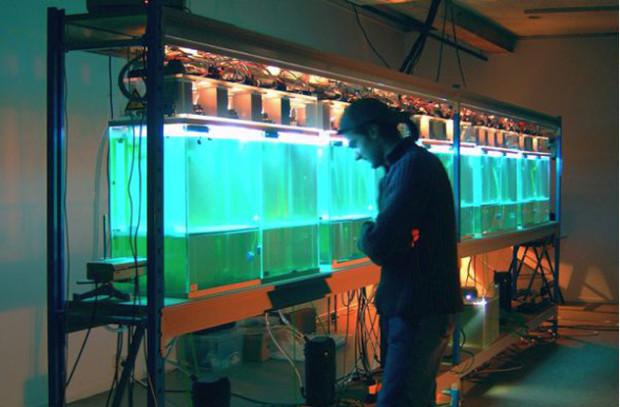
Of course, the "blue shift" affects a number of interesting questions: is it permissible to kill in the name of art, for example. But fish such problems do not worry - they really something to this question with certainty would answer "yes».
4. Clothes made of bacteria
Tired of wasting time running around the shops? Then buy a few cans of Kombucha Kombucha and grow their own clothes.
Of course, we have simplified everything, but something like this for many years doing fashion designer Suzanne Lee. With several million germs director of the research project «BioCouture» has created a line of jackets, shirts and shoes.

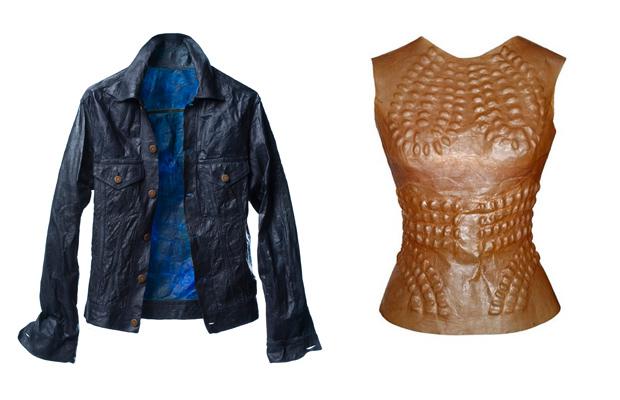
Lee first brew 30 liters of green tea and adds a lot of sugar. After the tea cools, Li adds a mixture of bacteria and yeast that eat sweet mix. In the process of being separated from the cellulose nanofiber is formed on top of the bath adhesive sheet. A few weeks later, Lee has a sheet of about 2, 5 cm thick. First, she washes and dries it, and then begins to create.
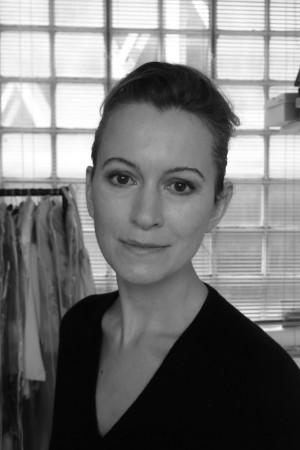
Texture creations Li depends a recipe that uses it. The material can be almost transparent, like a paper, or thick and rigid. Lee cuts the material into pieces and wrap them around the manikin. Threads merged together and end up with a full clothing.
Lee hopes to someday be able to make clothes from the microbes themselves. She also dreams of clothing that will nourish the body and even protect people from diseases.
5. Persons made from DNA
Most people do not pay any attention to adhering to the sidewalk chewing gum. But not Heather Dewey-Hagborg she spends her days on the streets in search of discarded chewing gum, cigarette butts, hair strands - the fresher the better. Dewey Hagborg uses these nasty at first glance tips to get an idea of other people's faces. Key - in the DNA.
His DNA, you scatter everywhere you throw a cigarette butt or losing hair - and leave the key to your identity. These keys Dewey Hagborg brings in Brooklyn biotech lab called «Genspace». There she selects from debris DNA sequences (e.g., those that are responsible for facial features and dimensions, gender, hair color, the probability of obesity and others), and drives data into a computer program. Then it creates a "portrait" of a smoker or a lover of chewing gum. Of course, people are not perfect copies of the originals, but, according to Dewey Hagborg "family resemblance" is.
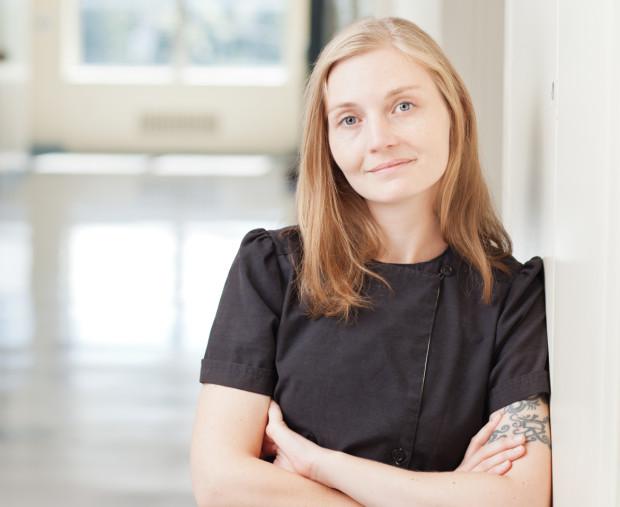
Since the New York artist is unable to determine the age of all its models look at 30 years old when she finishes a portrait, it prints it on a 3D-printer, and - voila! - Photography Camera.
The project entitled "Strange Vision" - a wonderful example of how far we have come in technology. Work Dewey Hagborg may be useful not only for the art - once the medical examiner asked her to help identify the body of an unknown man.

But there are a lot of terrible consequences. Even if the artist from the street can recreate the appearance of a stranger, then that government is capable of? Dewey Hagborg wants exactly that we are thinking. "Strange Vision" - is the question of privacy and surveillance. But one thing is certain: this project will make a person think twice before you throw a cigarette butt on the pavement.
6. Petunia with human genami
Eduardo Kac may not resemble the classic mad scientist, but do not let it fool you normal view. Brazilian artist known for his "transgenic art" - it changes the nature and creates new forms of life.

Here, for example, the fluorescent bunny. With the help of a French scientist Katz took from crystal jellyfish (this being of light in the dark) fluorescent protein. Katz then hoisted the rabbit egg protein, and in 2009 was born bioluminescent rabbit Alba. Whenever pipsqueak jumping under ultraviolet light, it glows green. Of course, the project angers animal rights, but that did not stop Katsu create another unusual hybrid.
In 2009, he introduced the world Eduniyu Katz - pink petunia with human genes. These genes are donated to Edunii personally Katz. The artist has asked scientists to take his blood, copy the genetic sequence of the immune system and to introduce a gene into a plant.

The immune system distinguishes between foreign bodies and external threats, so that the addition of such a gene in petunia symbolically means that Edunii have self-awareness. In addition, there are red streaks Edunii similar to blood vessels. Katz called his creation "rastilovekom" and proudly put on display on the display in Weisman Art Museum in Minneapolis.
"It lives - he said. - It is as real as you or me. Nature could not do anything like that, but I could. " Let us hope that this will stop a mad genius and not turn our little cozy world in Shop of Horrors.
7. Edible Opera
Let's be honest - not everyone likes the opera. But if you do not like what you hear, maybe you will like opera taste.

London artist Michael Burton and Michiko Nitta found a way to turn the voice of an opera singer in the unforgettable taste experience. Instead of pots and pans and Nitta Burton invented "algrakulturu" - science fiction suit pipes entwine around the wearer's body, with a tube inserted into the mouth. It so happened that the first owner of the suit became Louise Ashcroft - mezzo-soprano with a particularly strong voice.
Whenever Ashcroft sings, she exhales carbon dioxide, which goes down the tubes and eventually gets to the colonies of algae deep inside the suit. Eukaryotes consume carbon dioxide, but with the help of some high-speed performance of fertilizers by the end of Ashcroft they become large, tasty and ready to eat.
Not only is the breath of the singer plays a crucial role, the voice Ashcroft also affect the color, texture and taste of seaweed: how she sings, they can get bitter or sweet.
8. Cheese from human bacteria
You know, the smell of Limburger? Well, like the smell of sweaty feet, but it's not too surprising - after all, for the manufacture of Limburg cheese using the same bacteria that are responsible for the smell. Incidentally, many cheeses, such as parmesan and cheddar US, made of lactobacilli - the same microorganisms that are found in our digestive, urinary and reproductive system. Microbiologist Christine Agapakis and expert on smells Sissel Tolaas just decided to go a little further.
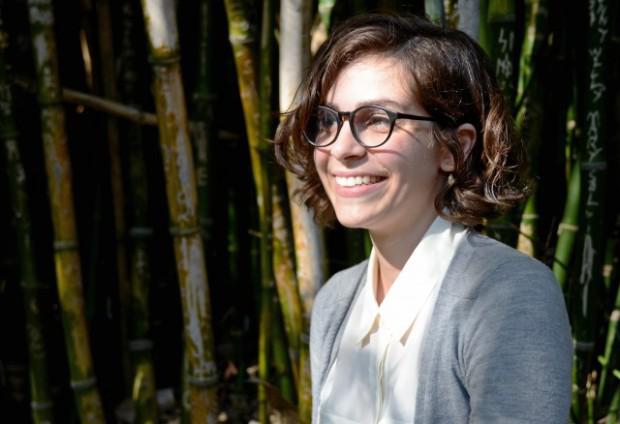
Agapakis Tolaas and took a cotton swab and apply them to different parts of the human body: the nostrils, in the mouth, on the navel, the eye to take a few tears, and even wiped swabs few toes. Then they mixed the microorganisms obtained in this way with fresh milk and created 11 cheeses, and each distinctly smelled its "donor". Unfortunately intrepid gourmet cheese is not intended for food - they have exhibits on display at the Science Gallery in Dublin "Grow Yourself ... Life after the nature».
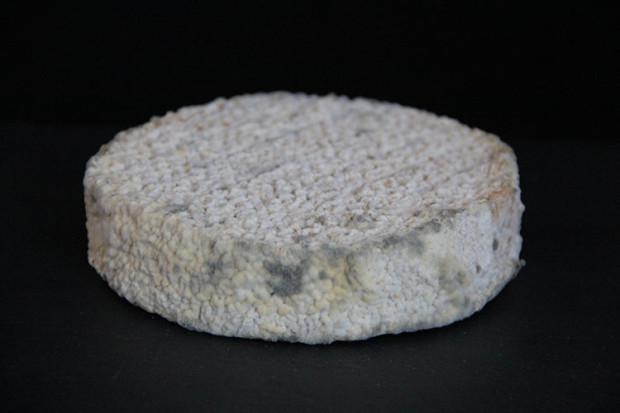
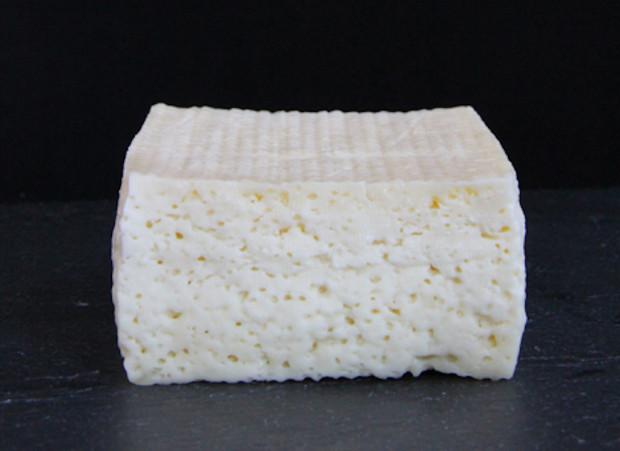
This project is called "Homemade" is to help people better understand the microbes and their role in human life - in particular, to make people wonder why they are so dirty that one can make cheese.
9. A person with third uhom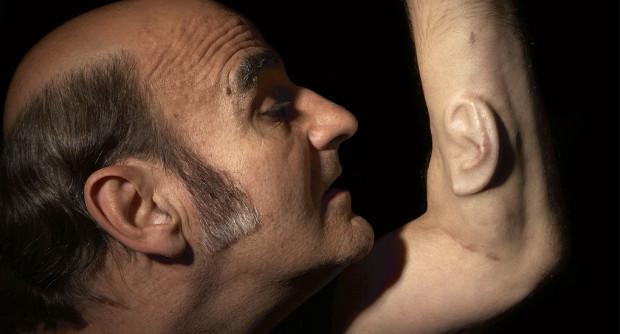
Australian artist Stelarc do not need a canvas - he draws on his body. Since 1970 Stelarc has already managed to hang himself in the air with metal hooks, wander around a giant robot to push the camera itself in the stomach, and even connect itself to the Internet. But in his last experiment, Stelarc has surpassed himself.
The project, called "ear on his arm" to its name: from Stelarc's own cells, and doctors have created biocompatible frame in the shape of the ear. In 2006, the year they are surgically implanted in the left forearm frame Stelarc, and now it has aborted third ear. Of course, ignored the new body could not remain Stelarc - different reactions, from curiosity to disgust. However, an artist with an ear is not finished - he wants to make several operations to increase the authority and capacity lobe.
The final stage is planned to provide an ear microphone and a wireless transmitter - Stelarc wants to connect the ear to the Internet, so that anyone could hear what he hears. He even wants to answer using the ear phone calls. Stelarc hear the caller's voice in his head implanted in the mouth thanks to the transmitter. Yes, here it is - a real man of art.
10. To give birth to a shark
The Japanese artist Ai Hasegawa faced with a double dilemma. First, she wanted to give birth, but is firmly convinced that the planet is already too many people walking. Secondly, she was worried about the environment, but appreciates the endangered species. Most people are not tied to these dilemmas among themselves, but Hasegawa decided to kill two birds with one stone - to give birth to a shark.
Hasegawa considered the possibility to have a dolphin or tuna, but eventually settled on korotkopёroy spiny dogfish. Why sharks? According to the artist, they are threatened with extinction, live almost as long as a man, and most importantly - they are delicious.
After birth, Hasegawa plans to release a shark in the wild - in her opinion, the fish need to spend some time in the ocean, to be delicious. Shark implant GPS-device, so that when someone catches it, Hasegawa would find it, buy a few pieces of fillet and eat their own "baby».
However, there is one "but": a man can not give birth to a shark. However, the expectant mother thinks that nature can deceive. She now works as a gynecologist, to increase their uterus and turn it into a sort of "Aquarium". It also plans to create a genetically modified "shark-human" placenta to save akulёnka of antibodies. Finally, she said that her mother would be the perfect someone who is rich, lonely and menopause - does not even have to take any medications to suspend monthly. And yet my mother should be like a shark.
It sounds like complete madness, but the project Hasegawa raises an interesting question. If a woman has endured an animal, is it ethical to eat it? Hasegawa itself considers that there is no problem - many fish, for example, eat their own eggs. In nature, this occurs every day.
via factroom.ru

Typically, we divide people into two categories: the analytical, scientific mind and creative. But in real life it's not so simple. There are a lot of artists from the sciences - people who converted to the work of the biology or meteorology. Sometimes very strange way.
1. The meteorite, which will fly back to space
About 5,000 years ago, the Earth fell iron meteorite. It happened near the modern Buenos Aires, Argentina. The meteorite, now known as Campo del Cielo, remained on Earth for thousands of years. Sometimes the natives otkovyrivali away pieces of metal to forge weapons, and some time later the Spaniards dug up the entire area in hopes of finding deposits of iron. And in the end it turned out to be a fragment of a meteorite in a Scottish artist Katie Paterson.

Paterson project called "Campo del Cielo: Golf heaven" sent to be melted meteorite - a piece of iron was melted, poured into a mold and gave the metal to solidify. Iron stone weighing 110 kg then exhibited at Selfridges, London.
But Paterson meteorite is not yet finished. The second phase of the project involves the launch of it back into space.
Paterson, enlist the help of the European Space Agency plans to send the meteorite back to the stars aboard a cargo carrier spacecraft. This is largely a symbolic gesture - Paterson hopes to inspire the next generation so that astronomers and make people think about the origin of life and the universe. That's how a lot of hopes are pinned on a small rock.
2. Clouds in the rooms
Clouds always fascinated people. Who once in my life did not look at the sky castles and furry elephants? Yes, and artists often depict clouds on his canvases - example is the "Scream" Munch or "eight bells" of Homer. A Dutch artist Berndnaut Smild became the first in the world of the creator's own clouds. He threw the brush and paints and rely on science to build real clouds.
Since 2012, the Smild traveled the globe in search of churches and galleries, suited to its meteorological magic. In the end, he finally found the perfect place, brought to the car and began to work. The room should be appropriate "climate" and Smild spends several days to adjust the temperature and humidity, water pouring floors. When the time came, he releases from his fog machine - and there is a cloud.

Sometimes Smild makes cumulus, sometimes rain, sometimes cirrus clouds. Unfortunately, there are only a few seconds - during this time, the artist manages to photograph their work. And, despite the scientific approach, Smilda interested in the ephemeral aspect of his work - the cloud lives just a moment, and then disappears.
3. Violet smeschenie

Art lovers, visit the "blue shift" Angelo Vermeulen in 2005, the year got a chance to demonstrate their divine powers. Moreover, an interactive installation that gave the visitors control over life and death, it also gave them the power of the creator.
Teaming up with an evolutionary biologist Luc De Meester, Vermeulen has built a number of aquariums in which swim hungry fish and water fleas. Aquariums have been divided horizontal leaky planks. Holes were small enough to hold the fish at the bottom, but large enough to crustaceans flea can swim freely back and forth. Of course, any water flea knows what is best to stay away from schools of fish, right? Well, it all depends on the lighting.

Located above the aquarium spotlights connected to motion sensors. Most of the time the lights were bright yellow, that fleas was very good - bright yellow light attracted fleas floating in the top of the aquarium. But blue water fleas do not like. Blue means for their open water and, accordingly, predators. Therefore, when a visitor came to the aquarium, yellow was replaced by blue and flea fled in panic to the bottom of the aquarium, to fish. In other words, every man approached the aquarium fleas doomed to destruction.
But some water fleas finally realized what was happening. They have overcome the natural fear of blue light and alive. It was a micro-evolution in action, adaptation to the enclosed space - exactly what I wanted to see Vermeulen.

Of course, the "blue shift" affects a number of interesting questions: is it permissible to kill in the name of art, for example. But fish such problems do not worry - they really something to this question with certainty would answer "yes».
4. Clothes made of bacteria
Tired of wasting time running around the shops? Then buy a few cans of Kombucha Kombucha and grow their own clothes.
Of course, we have simplified everything, but something like this for many years doing fashion designer Suzanne Lee. With several million germs director of the research project «BioCouture» has created a line of jackets, shirts and shoes.


Lee first brew 30 liters of green tea and adds a lot of sugar. After the tea cools, Li adds a mixture of bacteria and yeast that eat sweet mix. In the process of being separated from the cellulose nanofiber is formed on top of the bath adhesive sheet. A few weeks later, Lee has a sheet of about 2, 5 cm thick. First, she washes and dries it, and then begins to create.

Texture creations Li depends a recipe that uses it. The material can be almost transparent, like a paper, or thick and rigid. Lee cuts the material into pieces and wrap them around the manikin. Threads merged together and end up with a full clothing.
Lee hopes to someday be able to make clothes from the microbes themselves. She also dreams of clothing that will nourish the body and even protect people from diseases.
5. Persons made from DNA
Most people do not pay any attention to adhering to the sidewalk chewing gum. But not Heather Dewey-Hagborg she spends her days on the streets in search of discarded chewing gum, cigarette butts, hair strands - the fresher the better. Dewey Hagborg uses these nasty at first glance tips to get an idea of other people's faces. Key - in the DNA.
His DNA, you scatter everywhere you throw a cigarette butt or losing hair - and leave the key to your identity. These keys Dewey Hagborg brings in Brooklyn biotech lab called «Genspace». There she selects from debris DNA sequences (e.g., those that are responsible for facial features and dimensions, gender, hair color, the probability of obesity and others), and drives data into a computer program. Then it creates a "portrait" of a smoker or a lover of chewing gum. Of course, people are not perfect copies of the originals, but, according to Dewey Hagborg "family resemblance" is.

Since the New York artist is unable to determine the age of all its models look at 30 years old when she finishes a portrait, it prints it on a 3D-printer, and - voila! - Photography Camera.
The project entitled "Strange Vision" - a wonderful example of how far we have come in technology. Work Dewey Hagborg may be useful not only for the art - once the medical examiner asked her to help identify the body of an unknown man.

But there are a lot of terrible consequences. Even if the artist from the street can recreate the appearance of a stranger, then that government is capable of? Dewey Hagborg wants exactly that we are thinking. "Strange Vision" - is the question of privacy and surveillance. But one thing is certain: this project will make a person think twice before you throw a cigarette butt on the pavement.
6. Petunia with human genami

Eduardo Kac may not resemble the classic mad scientist, but do not let it fool you normal view. Brazilian artist known for his "transgenic art" - it changes the nature and creates new forms of life.

Here, for example, the fluorescent bunny. With the help of a French scientist Katz took from crystal jellyfish (this being of light in the dark) fluorescent protein. Katz then hoisted the rabbit egg protein, and in 2009 was born bioluminescent rabbit Alba. Whenever pipsqueak jumping under ultraviolet light, it glows green. Of course, the project angers animal rights, but that did not stop Katsu create another unusual hybrid.
In 2009, he introduced the world Eduniyu Katz - pink petunia with human genes. These genes are donated to Edunii personally Katz. The artist has asked scientists to take his blood, copy the genetic sequence of the immune system and to introduce a gene into a plant.

The immune system distinguishes between foreign bodies and external threats, so that the addition of such a gene in petunia symbolically means that Edunii have self-awareness. In addition, there are red streaks Edunii similar to blood vessels. Katz called his creation "rastilovekom" and proudly put on display on the display in Weisman Art Museum in Minneapolis.
"It lives - he said. - It is as real as you or me. Nature could not do anything like that, but I could. " Let us hope that this will stop a mad genius and not turn our little cozy world in Shop of Horrors.
7. Edible Opera
Let's be honest - not everyone likes the opera. But if you do not like what you hear, maybe you will like opera taste.

London artist Michael Burton and Michiko Nitta found a way to turn the voice of an opera singer in the unforgettable taste experience. Instead of pots and pans and Nitta Burton invented "algrakulturu" - science fiction suit pipes entwine around the wearer's body, with a tube inserted into the mouth. It so happened that the first owner of the suit became Louise Ashcroft - mezzo-soprano with a particularly strong voice.
Whenever Ashcroft sings, she exhales carbon dioxide, which goes down the tubes and eventually gets to the colonies of algae deep inside the suit. Eukaryotes consume carbon dioxide, but with the help of some high-speed performance of fertilizers by the end of Ashcroft they become large, tasty and ready to eat.
Not only is the breath of the singer plays a crucial role, the voice Ashcroft also affect the color, texture and taste of seaweed: how she sings, they can get bitter or sweet.
8. Cheese from human bacteria
You know, the smell of Limburger? Well, like the smell of sweaty feet, but it's not too surprising - after all, for the manufacture of Limburg cheese using the same bacteria that are responsible for the smell. Incidentally, many cheeses, such as parmesan and cheddar US, made of lactobacilli - the same microorganisms that are found in our digestive, urinary and reproductive system. Microbiologist Christine Agapakis and expert on smells Sissel Tolaas just decided to go a little further.

Agapakis Tolaas and took a cotton swab and apply them to different parts of the human body: the nostrils, in the mouth, on the navel, the eye to take a few tears, and even wiped swabs few toes. Then they mixed the microorganisms obtained in this way with fresh milk and created 11 cheeses, and each distinctly smelled its "donor". Unfortunately intrepid gourmet cheese is not intended for food - they have exhibits on display at the Science Gallery in Dublin "Grow Yourself ... Life after the nature».


This project is called "Homemade" is to help people better understand the microbes and their role in human life - in particular, to make people wonder why they are so dirty that one can make cheese.
9. A person with third uhom

Australian artist Stelarc do not need a canvas - he draws on his body. Since 1970 Stelarc has already managed to hang himself in the air with metal hooks, wander around a giant robot to push the camera itself in the stomach, and even connect itself to the Internet. But in his last experiment, Stelarc has surpassed himself.
The project, called "ear on his arm" to its name: from Stelarc's own cells, and doctors have created biocompatible frame in the shape of the ear. In 2006, the year they are surgically implanted in the left forearm frame Stelarc, and now it has aborted third ear. Of course, ignored the new body could not remain Stelarc - different reactions, from curiosity to disgust. However, an artist with an ear is not finished - he wants to make several operations to increase the authority and capacity lobe.
The final stage is planned to provide an ear microphone and a wireless transmitter - Stelarc wants to connect the ear to the Internet, so that anyone could hear what he hears. He even wants to answer using the ear phone calls. Stelarc hear the caller's voice in his head implanted in the mouth thanks to the transmitter. Yes, here it is - a real man of art.
10. To give birth to a shark
The Japanese artist Ai Hasegawa faced with a double dilemma. First, she wanted to give birth, but is firmly convinced that the planet is already too many people walking. Secondly, she was worried about the environment, but appreciates the endangered species. Most people are not tied to these dilemmas among themselves, but Hasegawa decided to kill two birds with one stone - to give birth to a shark.
Hasegawa considered the possibility to have a dolphin or tuna, but eventually settled on korotkopёroy spiny dogfish. Why sharks? According to the artist, they are threatened with extinction, live almost as long as a man, and most importantly - they are delicious.
After birth, Hasegawa plans to release a shark in the wild - in her opinion, the fish need to spend some time in the ocean, to be delicious. Shark implant GPS-device, so that when someone catches it, Hasegawa would find it, buy a few pieces of fillet and eat their own "baby».
However, there is one "but": a man can not give birth to a shark. However, the expectant mother thinks that nature can deceive. She now works as a gynecologist, to increase their uterus and turn it into a sort of "Aquarium". It also plans to create a genetically modified "shark-human" placenta to save akulёnka of antibodies. Finally, she said that her mother would be the perfect someone who is rich, lonely and menopause - does not even have to take any medications to suspend monthly. And yet my mother should be like a shark.
It sounds like complete madness, but the project Hasegawa raises an interesting question. If a woman has endured an animal, is it ethical to eat it? Hasegawa itself considers that there is no problem - many fish, for example, eat their own eggs. In nature, this occurs every day.
via factroom.ru
Bird talking to people on the phone in Japanese
Stephen Hawking argues that the evolution of the human mind will bring more harm than good

